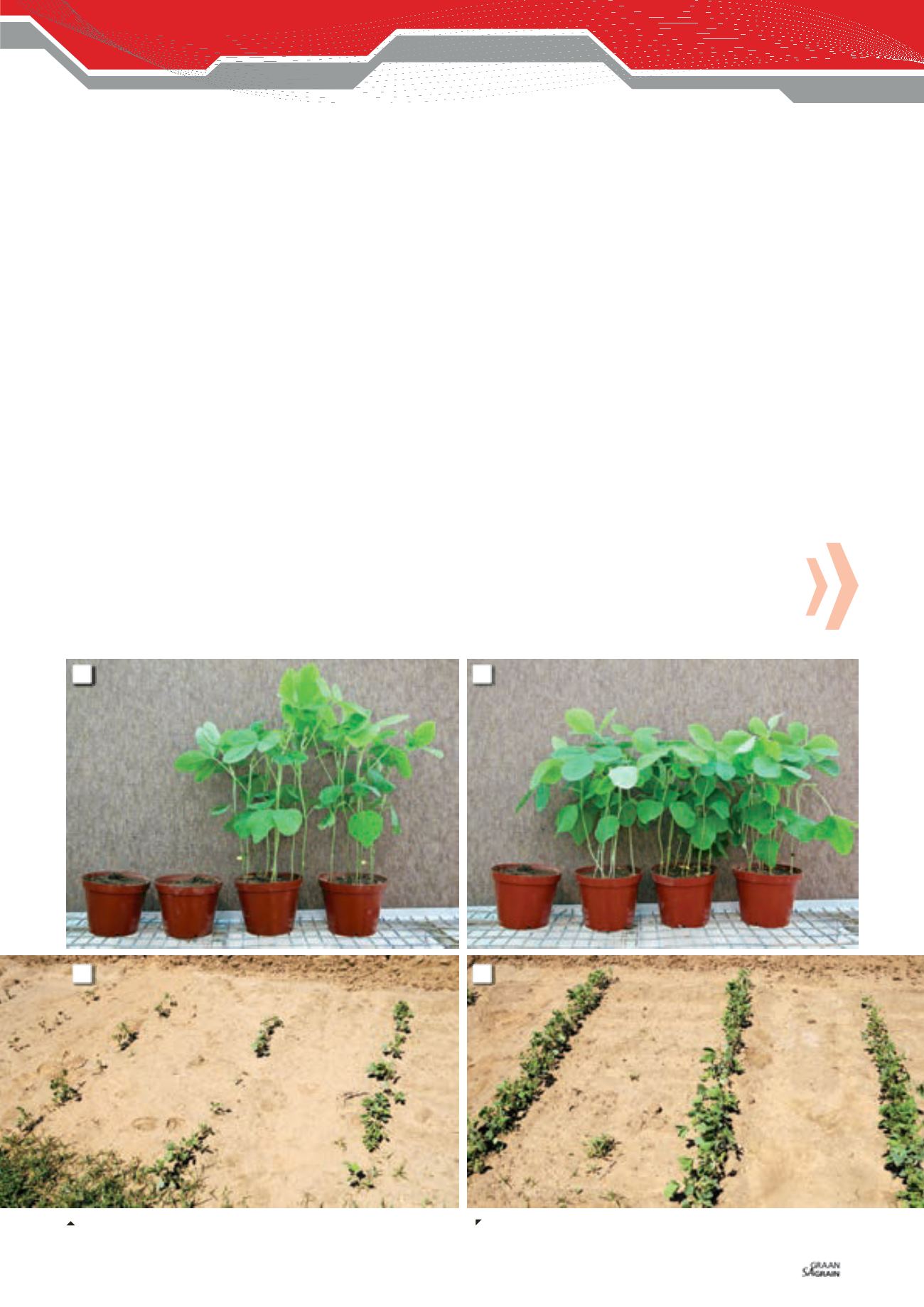

59
Survival of soybean seedlings planted in pasteurised soils were
significantly higher than those planted in non-pasteurised soils col-
lected from all areas (
Photo 1
).
Isolations were made from diseased soybean plants that were
collected from all the areas sampled. It was found that 71 fungal
species were obtained from soybean crowns, hypocotyls, cotyle-
dons and roots.
A large number of isolates representing each species from different
genera were tested to determine their importance in causing dis-
ease on soybean plants under glasshouse conditions. Of the 71 fun-
gal species,
Fusarium (F. begoniae, F. graminearum, F. oxysporum,
F. solani)
(
Photo 2
),
Pythium (P. aphanidermatum, P. heterothalli-
cum, P. irregulare, P. ultimum)
(
Photo 3
) and
Rhizoctonia solani
(AG-2-2 IIIB, AG-4 HG-III) (
Photo 4
) caused root rot and/or damp-
ing-off,
Sclerotium rolfsii
is reported to cause southern blight and
Diaporthe/Phomopsis
spp. complex are causal agents of stem
blight in South Africa.
Seed treatment trials
In glasshouse experiments six fungicide seed treatments were
evaluated against the most important soilborne pathogens of soy-
bean. ST1 (a.i. mefenoxam), ST2 (a.i. fludioxonil + mefenoxam),
ST3 (a.i. azoxystrobin + fludioxonil + mefenoxam), ST4 (a.i. thia-
bendazole + azoxystrobin + fludioxonil + mefenoxam), ST5
(a.i. penflufen + prothioconazole + metalaxyl) and ST6 (a mixture
of ST1 [a.i. mefenoxam] + ST2 [a.i. fludioxonil + mefenoxam] fungi-
cides) were evaluated as seed treatments for their effects on survival,
growth and root rot of seedlings in soil infested with
Fusarium
spp
.
(F. begoniae, F. graminearum, F. oxysporum, F. solani), Pythium
spp.
(P. aphanidermatum, P. heterothallicum, P. irregulare, P. ultimum)
,
and
R. solani
(AG-2-2 IIIB, AG-4 HG-III).
Results of the effect of fungicide seed treatment on survival of
soybean seedlings grown in soil infested with important soilborne
pathogens showed that pre- and post-emergence damping-off of
soybean caused by important soilborne pathogens of soybean can
be effectively controlled by ST3, ST4, ST5 and ST6.
However, ST4 and ST5 are more effective against
Fusarium
spp.
Although seed treatment with ST1 was effective in reducing dam-
age caused by
Pythium
species, it was not effective against other
soilborne pathogens of soybean. On the other hand, ST2 was ef-
fective in reducing damage caused by
R. solani
AG-2-2IIIB and
AG-4 HGIII and although it reduced damping-off of soybeans caus-
ed by
Pythium
species, in most cases it was not as effective as ST6
(
Photo 5
).
Pilot field trials
The results of this study, which were done under glasshouse
conditions, need to be verified under field conditions to be consid-
ered reliable. For this purpose, commercially available fungicides
that were evaluated under glasshouse conditions will be used to
test their ability to control soilborne diseases of soybean under field
conditions.
In a pilot trial one fungicide (ST6) was used as seed treatment and
treated seeds were planted in three areas (Bethlehem, Brits and
Groblersdal).
5a and 5b: Planting medium inoculated with
R. solani
AG-4 HGIII and
planted to seeds treated with the different fungicides.
6a and 6b: Pilot seed treatment trial at Bethlehem planted with:
a) non-treated soybean seeds and b) soybean seeds treated with ST6.
1a5
6a
5b
6b
No seed
treatment
No seed
treatment
ST1
ST3
ST2
ST4
ST6
ST5

















